Bathroom sizes range from compact 60 square feet (5 square meters) to spacious master bathrooms exceeding 150 square feet (13 square meters), with luxury suites reaching over 220+ square feet (20 square meters). In average homes, ceiling heights span from 8 feet (2.4 meters) to 9 feet (2.7 meters) in more luxurious spaces. Rectangular or square shapes are standard, optimizing functionality and space usage. The primary purposes of bathrooms include hygiene, storage, relaxation, and adding value to a home. They are essential for routine personal care and provide space for storing bathroom essentials. Common bathroom furniture includes vanity units, mirrors, linen cabinets, shower stools or benches, over-the-toilet storage, medicine cabinets, and floor cabinets. The choice of bathroom colors, such as white, light blue, gray, beige, seafoam green, powder pink, and navy blue. Functional bathrooms require a well-thought-out layout, sufficient storage, appropriate lighting, adequate ventilation, and durable materials. Architects can significantly contribute to bathroom renovations, especially when structural changes are involved. Redecorating a bathroom can take 2 to 4 weeks, depending on the extent of changes and potential delays. Homeowners face challenges like budget constraints, design decisions, finding reliable contractors, unexpected issues, lack of experience, balancing aesthetics and functionality, and time management.
What is the typical size of a bathroom?
A typical residential bathroom size ranges between 60 square feet (5 square meters) and 80 square feet (7 square meters). This allows fitting essential bathroom elements like a 2-foot (0.6 meter) x 3-foot (0.9 meter) shower, 2-foot (0.6 meter) x 1.5-foot (0.5 meter) sink vanity, and toilet within the space. The average ceiling height is 8 feet (2.4 meters), accommodating a standard showerhead. The footprint enables one person to utilize fixtures and move around comfortably. The average home bathroom measures between 80 square feet (7 square meters) and 110 square feet (10 square meters). With a typical 8-foot (2.4 meters) ceiling height, average baths fit a 3-foot (0.9 meters) x 3-foot (0.9 meters) shower, 3-foot (0.9 meters) x 2-foot (0.6 meters) double-sink vanity, toilet, and freestanding bathtub. The larger footprint allows multiple people, such as families, to get ready concurrently and adds more open floor space.
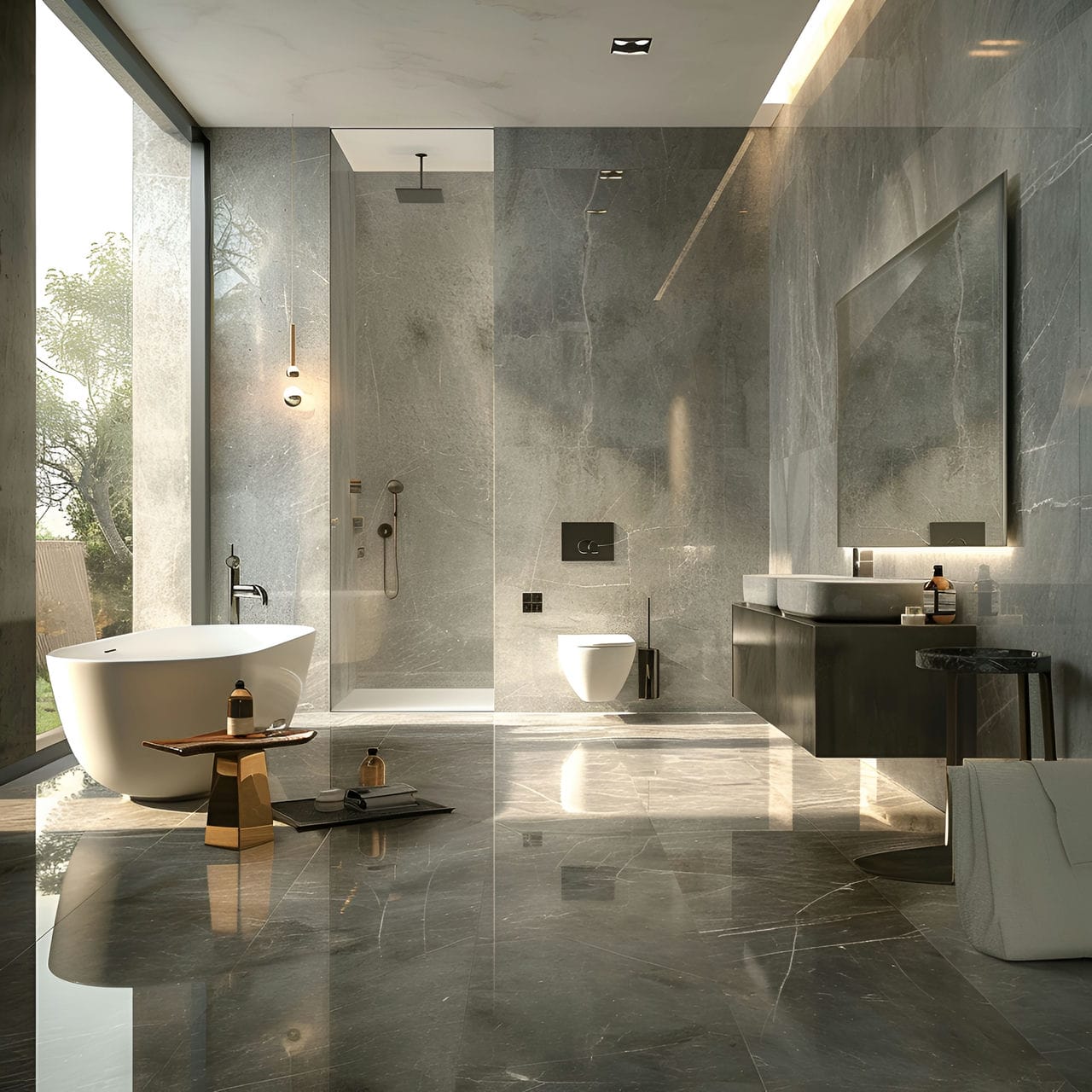
Spacious master bathrooms often exceed 150 square feet (13 square meters), though elite luxury suites reach 220+ square feet (20+ square meters). With soaring 9-foot (2.7 meters) ceilings, these accommodations allow for amenities like 5-foot (1.5 meters) x 3.5-foot (1-meter) designer showers, 4-foot (1.2 meters) vanities, and custom relaxation tubs. Baths may also incorporate separate water closets, private dressing rooms, spa facilities like saunas, fireplaces, and designs that maximize natural light.
What is the use and purpose of a bathroom?
The purpose of a bathroom is for hygiene, storage, relaxation, and influencing home value. Firstly, it is a space for attending to personal hygiene and bodily functions. All the sources emphasize that bathrooms allow people to perform essential routines like using the toilet, bathing, grooming, etc. Secondly, a bathroom provides storage for towels, toiletries, medications, and cleaning supplies. Having designated places to organize these essentials makes them easily accessible when needed. Thirdly, bathrooms can serve as private sanctuaries for relaxation and solitude. Multiple sources highlight how bathrooms allow people to retreat from the world, decompress after a stressful day, or find moments of inspiration. Lastly, bathrooms play a role in establishing a home’s value and setting the decorative tone for the rest of the house. Well-designed and maintained bathrooms can enhance the marketability and appeal of a property.
What is the typical shape of a bathroom?
The typical shapes of a bathroom are rectangles or squares spanning 5 feet (1.5 meters) to 8 feet (2.5 meters) across the maximum lengths/widths for maneuvering efficiency. A bathroom floorplan is usually more extended, ranging from 5 feet (1.5 meters) to 6.5 feet (2 meters) in one direction to accommodate stacked functions in sequence down one wall, such as locating the bathtub and then the toilet beside the required clearances. The narrow direction then ranges from 4 feet (1.2 meters) to 6 feet (1.8 meters), allowing clear space to access doors, cabinets, the shower, or vanity on the adjacent walls and still move around comfortably. Rectangular plans maximize the practical, usable floor space with all fixtures and storage furniture. For contemporary bathrooms or those integrating the toilet and shower/tub areas more openly, a square floorplan with dimensions ranging from 6 feet (1.8 meters) to 8 feet (2.5 meters) on every side also works. The consistent side lengths center all elements with pathways around them.
What furniture commonly equips a bathroom?
Listed below are the types of furniture commonly equip a bathroom:
- Vanity Units: Vanity units are a staple in bathroom furniture. They serve as the central hub for many bathroom activities, including washing hands, brushing teeth, and applying makeup. Vanity units often include a sink, countertop, and storage space underneath for toiletries and cleaning supplies.
- Mirrors: Mirrors are essential for practical use and aesthetic appeal in a bathroom. Mirrors can be standalone furniture or part of a cabinet or vanity unit. Some mirrors come with built-in lighting or anti-fog features for added convenience.
- Linen Cabinets: Linen cabinets store towels, washcloths, and other bathroom essentials. These furniture can be freestanding or wall-mounted, with shelves or drawers. Linen cabinets help keep the bathroom organized and clutter-free, and they can add a decorative element to the room.
- Shower Stools or Benches: A shower stool or bench can add comfort and safety to the bathroom, especially for those with mobility issues. This furniture can serve as a place to rest or to hold towels or toiletries during a bath or shower. These pieces can be made from water-resistant materials like teak or plastic.
- Over-the-Toilet Storage: Over-the-toilet storage units use vertical space in the bathroom, providing extra room for toiletries, towels, and decorative items. This furniture includes shelves or cabinets that fit snugly over a toilet, making them a smart choice for smaller bathrooms.
- Medicine Cabinets: Medicine cabinets in a bathroom are wall-mounted units with mirrored fronts. This furniture provides storage for medications, toiletries, and other small items. Some medicine cabinets have adjustable shelves, allowing customization based on the user’s needs.
- Floor Cabinets: Floor cabinets are versatile pieces of bathroom furniture that offer additional storage space. They can be placed in corners or other unused spaces, including shelves or drawers. Floor cabinets can store more oversized items like cleaning supplies or bulk toiletries, helping keep the bathroom tidy and organized.
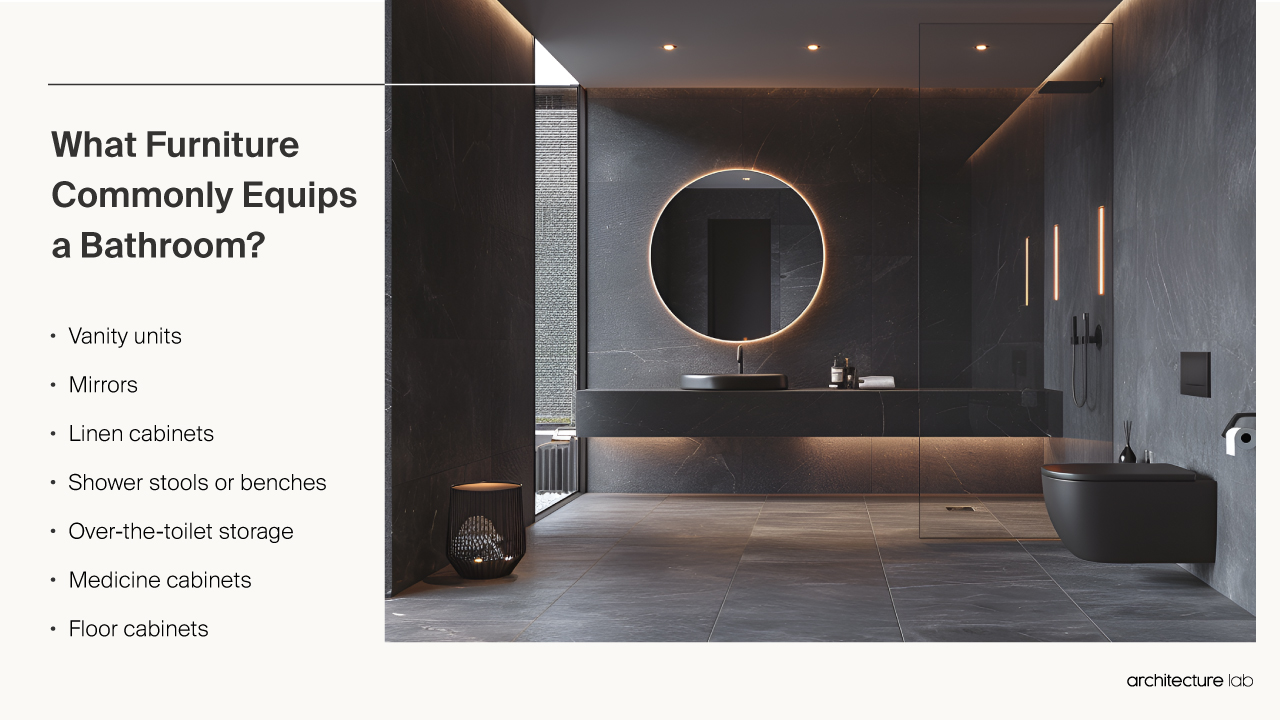
What is the normal ceiling height of a bathroom?
The normal ceiling height in residential bathrooms ranges from 7.5 feet (2.3 meters) to 8.2 feet (2.5 meters). Standard ceilings allow sufficient clearance for most common shower heads positioned 6.5 feet (2 meters) high and traditional bathroom light fixtures mounted just above. Bathrooms with a tub maintain 25 square feet (2.3 square meters), while a stall shower-only bath may reduce fractionally to 22 square feet (2.2 square meters) when footprint space is at a premium. Contemporary designs incorporate slightly taller ceilings, averaging 27 square feet (2.5 square meters) up to 29 square feet (2.7 square meters), which provides a feeling of openness and allows for regularly sized rainshower shower heads to be installed higher. Luxury master bathrooms or those with skylights or structural architectural details often exceed 32 square feet (3 square meters), though any ceiling below 22 square feet (2.2 square meters) starts to feel cramped.
What colors are bathrooms usually painted?
Listed below are the colors usually used in bathrooms painted:
- White: Bathrooms feature white for its clean and fresh appearance. This color reflects light, making the bathroom feel more spacious and bright. White provides a timeless look and is versatile, quickly matching with various fixtures and accessories.
- Light Blue: Light blue color in bathrooms offers a calming effect. Pale blue works well with white accents, enhancing the feeling of cleanliness and freshness.
- Gray: Gray in bathrooms adds a modern and sophisticated touch. From light to dark shades, this color offers versatility and can create a range of atmospheres, from soft and soothing to bold and dramatic.
- Beige: Beige in bathrooms creates a warm and inviting space. This neutral color brings a sense of calm and is ideal for those seeking a natural, understated look—beige pairs well with natural elements like wood and stone, adding to the room’s cozy feel.
- Seafoam Green: Seafoam green in bathrooms introduces a soft and refreshing touch. This color is reminiscent of the ocean and has a soothing effect, creating a spa-like feel. It pairs with white or light wood accents, enhancing the ambiance.
- Powder Pink: Powder pink in bathrooms adds a gentle and soothing presence. This soft hue brings warmth and is perfect for creating a feminine or vintage aesthetic. Powder pink works well with white and gray accents, offering a chic and tranquil space.
- Navy Blue: Navy blue in bathrooms makes a bold and elegant statement. This deep, rich color adds a touch of luxury and can be used as an accent wall or in decor elements. Navy blue pairs well with gold or brass fixtures, bringing a sophisticated contrast to the space.
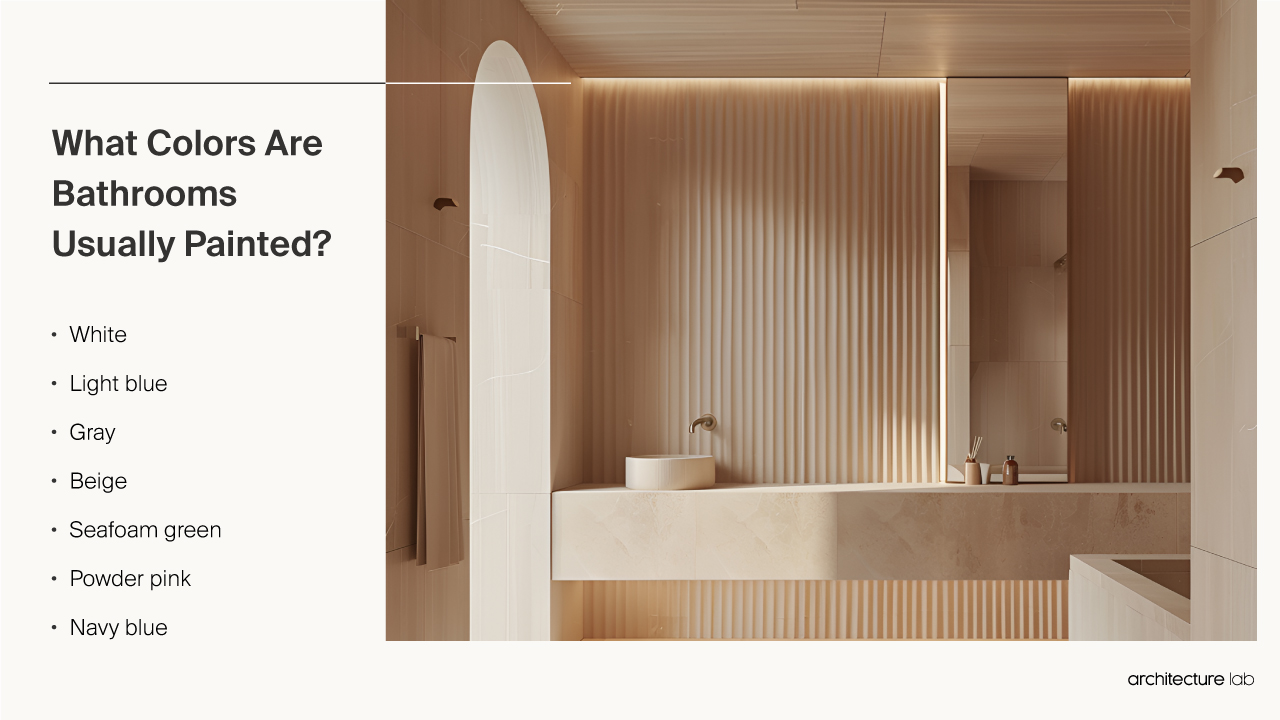
What makes the bathroom functional?
The bathroom is functional with a well-thought-out layout, sufficient storage, appropriate lighting, adequate ventilation, and durable, easy-to-clean materials. Firstly, the layout is foundational for a functional bathroom. It should facilitate easy movement and access to critical fixtures like the toilet, sink, shower, or bathtub. A well-planned layout is crucial in smaller bathrooms to maximize space and ensure comfort during use. Secondly, adequate storage significantly contributes to functionality. Proper storage solutions like cabinets, shelves, and vanity units are essential for organizing toiletries, towels, and cleaning supplies. Thirdly, good lighting is vital. Adequate natural and artificial lighting is necessary for daily grooming tasks. It should be bright enough for clarity and adjustable to create a relaxing atmosphere. Fourthly, adequate ventilation is essential for maintaining a healthy environment. Proper ventilation prevents the buildup of moisture and humidity. Lastly, the choice of materials impacts functionality—surfaces in the bathroom need to be durable, water-resistant, and easy to clean. Materials like ceramic tiles for flooring and walls are popular due to their resistance to moisture and ease of maintenance.
How is energy efficiency achieved in a bathroom?
Energy efficiency is achieved in a bathroom by installing water-conserving fixtures, regulating water temperatures, upgrading lighting, improving insulation and air sealing, and utilizing renewable energy sources. Firstly, energy efficiency in the bathroom starts with water conservation. Installing low-flow showerheads and toilets can reduce water usage. Secondly, regulating and monitoring water temperatures helps save energy for heating. Set the water heater temperature to 48°C (120°F) to balance comfort and greenhouse efficiency. Insulate hot water pipes to minimize heat loss as hot water travels to fixtures. Install timers or smart home technology to control water heating, only heating water during peak usage. Consider tankless water heaters that heat water on demand rather than maintaining a hot water tank. Thirdly, energy-efficient lighting like LED bulbs can reduce lighting energy usage by 75% or more compared to incandescent bulbs. LEDs last 25 times longer than incandescent, meaning fewer bulb replacements. Install occupancy sensors or timers so lights turn off automatically when not in use. Fourthly, add insulation to exterior bathroom walls and ceilings to prevent heat loss, reducing energy usage for heating and cooling. Ensure air sealing around windows, doors, pipes, and wiring holes to minimize air leaks. Lastly, renewable energy sources like solar panels can offset some or all of the energy used to power bathroom fixtures and appliances. Solar water heating systems can provide 60-80% of hot water needs.
How much does it typically cost to renovate a bathroom?
Renovating a small 30 square foot (2.5 square meter) bathroom with cosmetic refreshes like paint and new fixtures runs from $3,000 (€2,700, £2,300) to $5,000 (€4,500, £3,800). Layout changes are restricted. Updating an average existing 60-90 square foot (5-8 square meter) main residential bathroom starts at $6,000 (€5,400, £4,500) and can go up to $15,000 (€13,500, £11,400) depending on materials and features. New toilets typically cost between $300 (€270, £225) to $1,000 (€900, £750), while bathtubs range from $1,000 (€900, £750) to $5,000 (€4,500, £3,800). Custom vanities range from $2,000 (€1,800, £1,500) to $7,000 (€6,300, £5,300), and luxurious showers with body sprays or stone can exceed $10,000 (€9,000, £7,600). For spacious designer bathrooms exceeding 100 square feet (10 square meters), budgets can reach from $15,000 (€13,500, £11,400) to $25,000 (€22,500, £18,900), covering features like heated floors, electronic bidets, and premium materials. High-end master suites with the finest fixtures available range from $25,000 (€22,500, £18,900) to $35,000+ (€31,500+, £26,500+).
What factors affect the bathroom renovation?
Listed below are the factors that affect the bathroom renovation:
- Design and Aesthetic Choices: Design and aesthetic choices will impact bathroom renovation. This includes decisions about the color scheme, fixtures, and fittings, the materials used for surfaces such as the floor and walls, and the bathroom’s overall style. These choices will influence the renovation’s cost, timeline, and complexity.
- Budget: Budget is a crucial factor in a bathroom renovation. It determines what can afford to change, the materials’ quality, and hiring professionals for specific tasks. The budget should account for everything from the cost of new fixtures and fittings to the labor costs for installation.
- Hidden Damage: Bathrooms are subject to hidden damage due to water leaks or mold. Such damage may only be apparent once the renovation begins. Dealing with these issues can extend the project’s timeline and increase the cost.
- Contractor Selection: The contractor chosen to work with can impact the outcome of bathroom renovation. Factors to consider include the contractor’s experience, reputation, specialization in bathroom renovations, and whether they carry appropriate insurance.
- Plumbing and Electrical Work: Plumbing and electrical work are significant components of a bathroom renovation. The condition of the existing plumbing and electrical systems, the changes it wants to make, and local regulations can all affect these aspects of the renovation.
- Functionality and Practicality: The bathroom’s functionality and practicality should be considered. This includes taking into account the bathroom’s size, the number of people using it, storage needs, and features such as a walk-in shower or double sinks.
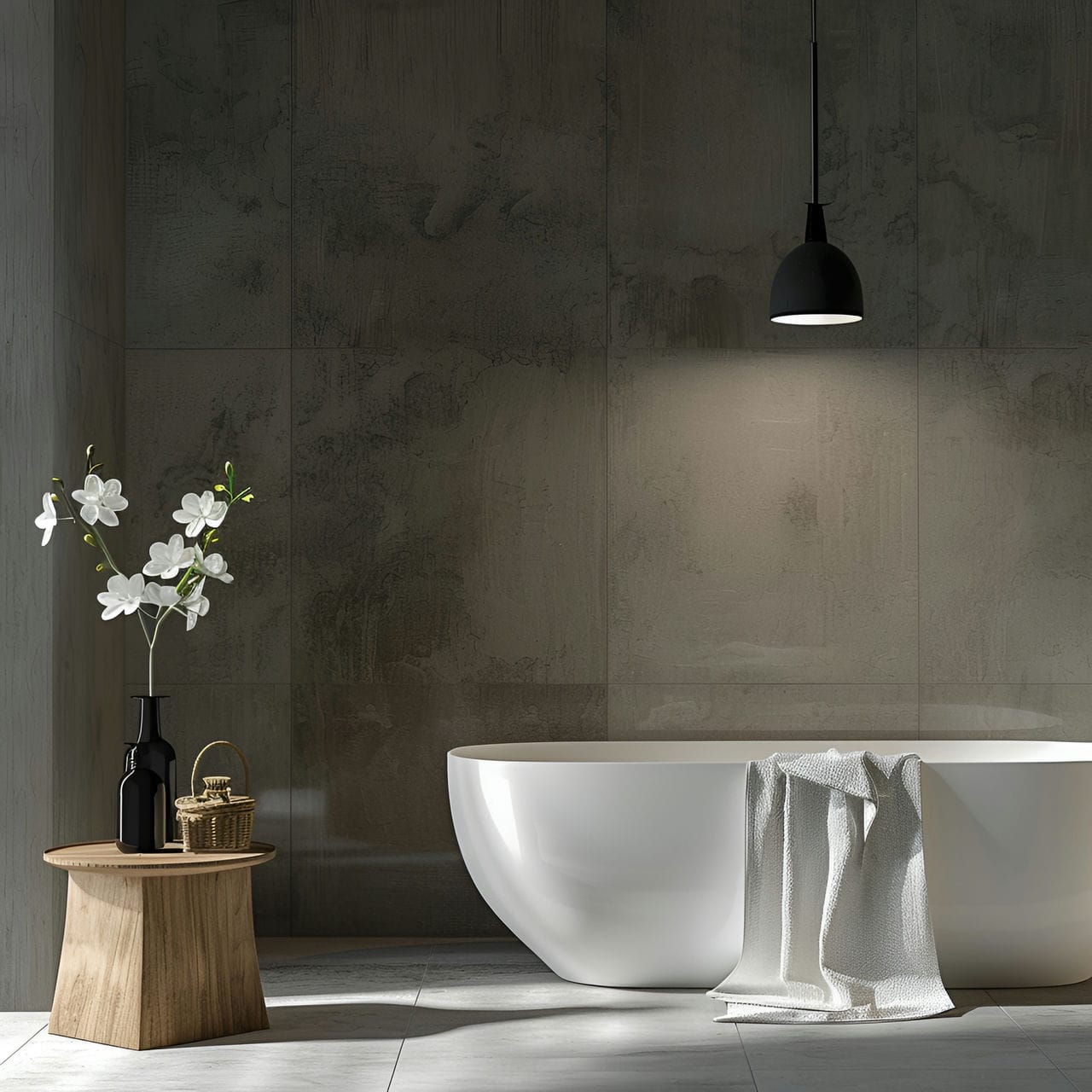
Is an architect required to renovate a bathroom?
No, an architect is not required to renovate a bathroom, but it is highly advised to hire where significant structural changes are planned. An architect’s expertise is invaluable when reconfiguring the layout, expanding the space, or integrating complex design elements. They bring a deep understanding of space utilization, ensuring that the new design is pleasing but also functional and compliant with building codes and regulations. For substantial renovations beyond cosmetic updates, an architect can provide creative solutions to challenges such as optimizing small spaces or integrating modern amenities. Their involvement can also be crucial in managing the project, coordinating with contractors, and ensuring the renovation meets the homeowner’s expectations and legal requirements.
How can an architect help you upgrade a bathroom?
Listed below are the ways that an architect can help an owner upgrade a bathroom:
- Spatial Planning: An architect can help optimize the use of space in the bathroom. They can create a layout that maximizes functionality and flow, ensuring the new design accommodates all needs. This might include reconfiguring the layout to add a walk-in shower and double sinks or expanding the bathroom by moving walls.
- Design Vision: Architects bring a professional design vision to bathroom upgrades. They can help choose a cohesive look that aligns with style and the rest of the home. This includes selecting materials, colors, and fixtures that create an appealing space.
- Technical Expertise: Architects have the expertise to navigate complex structural changes in the bathroom. An architect can provide the necessary drawings and calculations to ensure the changes are safe and compliant with building codes.
- Project Management: An architect can serve as a project manager for bathroom renovation. They can oversee the project from start to finish, coordinating with contractors, plumbers, and electricians to ensure the work is completed to a high standard and on schedule.
- Sustainability: An architect can incorporate sustainable design principles into a bathroom renovation. They can advise on energy-efficient lighting, water-saving fixtures, and environmentally friendly materials, helping to reduce the ecological footprint of bathrooms.
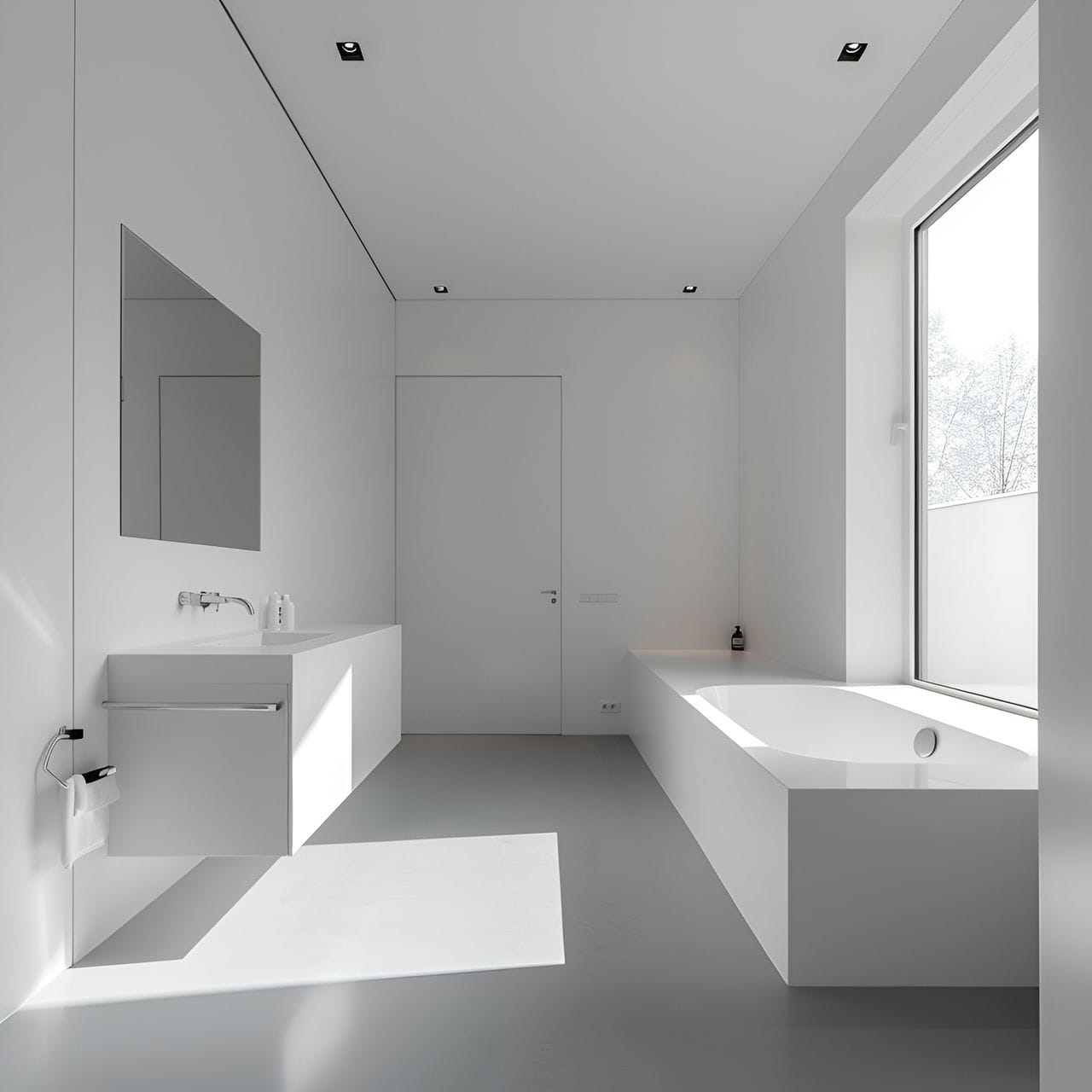
How much does it cost to hire an architect to renovate a bathroom?
The average cost to hire an architect to design a residential bathroom renovation ranges from $1,000 (€900, £750) to $5,000 (€4,500, £3,800) based on the scale and custom details involved. Most architects charge $100 (€90, £75) to $175 (€155, £135) per hour. Refreshing a small 30 square foot (2.5 square meters) powder room with new finishes and fixtures takes 6-10 hours for fees $1,000 (€900, £750) to $1,500 (€1,350, £1,150). Transforming an average 60 square foot (5 square meters) to a 90 square foot (8 square meters) existing bathroom incorporating some layout changes like reworked plumbing, added windows, or built-ins requires 15-25 architectural hours averaging $2,000 (€1,800, £1,500) to $3,500 (€3,150, £2,600). Top-tier designers tailoring high-end contemporary master suites and luxury spa bathrooms over 100 square feet (10 square meters) with premium details charge $5,000+ (€4,500+, £3,800+). Their elaborate plans can take 30-50+ hours coordinating with engineers on particular features.
Is it worth it to hire an architect to upgrade a bathroom?
Yes, hiring an architect to upgrade a bathroom is often worth it, particularly for substantial renovations. An architect brings specialized design and space optimization expertise, crucial in a bathroom where every inch counts. They can address limited space, awkward layouts, or specific functional needs, making the area more efficient and pleasing. An architect’s involvement is also beneficial for integrating modern amenities and ensuring the design complies with building codes and regulations. Investing in an architect’s services can be invaluable for those seeking to add significant value to their home or achieve a specific vision for their bathroom.
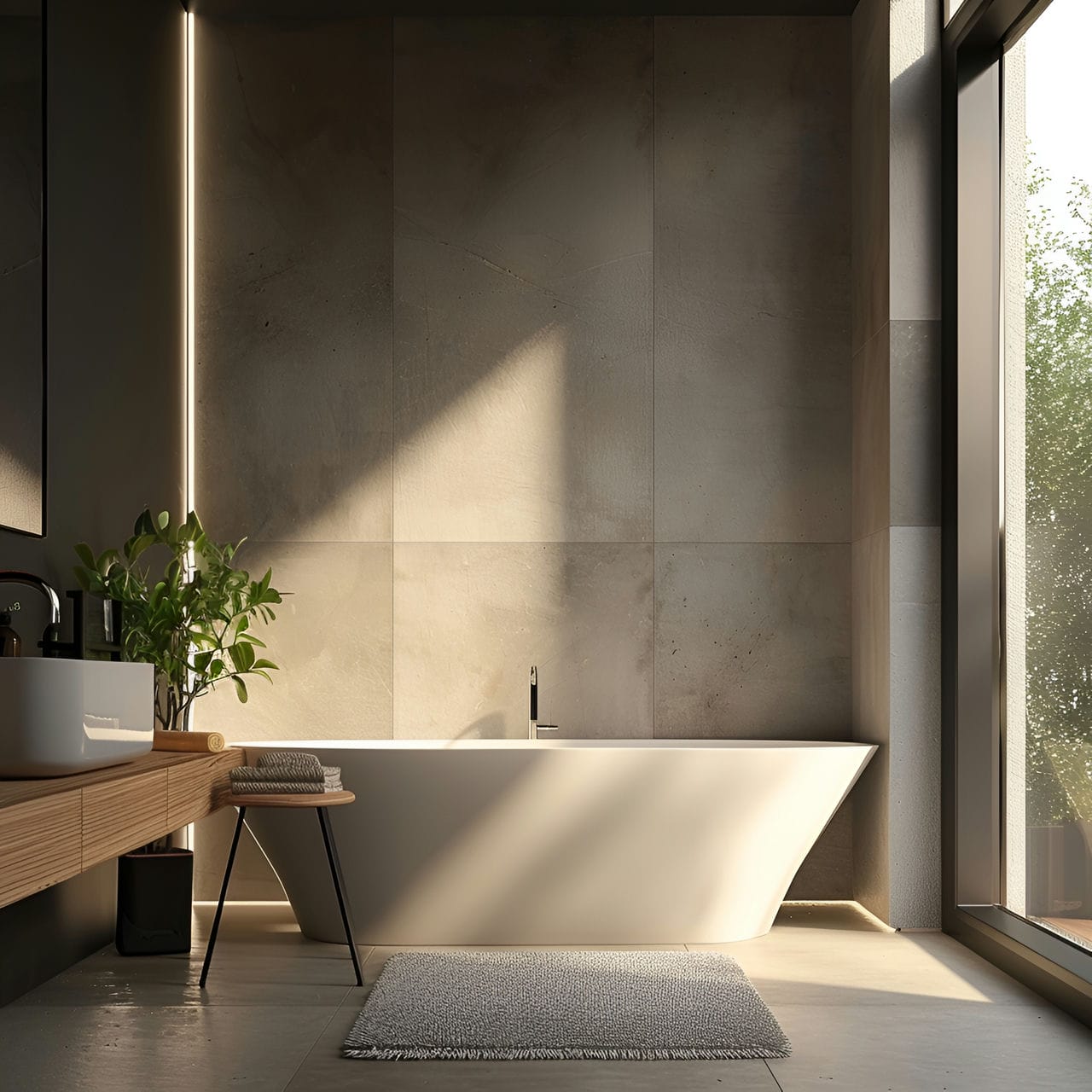
How long is needed to redecorate a bathroom?
2 to 4 weeks is needed to redecorate the bathroom. Firstly, simple updates like repainting or changing fixtures can be completed within a week. These tasks are straightforward and don’t require extensive modifications to the space. Secondly, more involved projects like installing new tiles, replacing a bathtub, or updating the vanity and sink can extend the timeline to 2 to 3 weeks. These tasks often require professional assistance and can involve more detailed work. Thirdly, if the redecoration includes significant structural changes, such as altering the layout or moving plumbing fixtures, the project could take 4 weeks or more. These renovations require more planning, labor, and, potentially, the acquisition of permits. Fourthly, the availability of materials and contractors can also affect the timeline. Delays in obtaining the necessary materials or scheduling professional help can extend the project duration. Lastly, unforeseen issues not uncommon in bathroom renovations, like discovering water damage or plumbing problems, can further prolong the process.
What are the struggles of the homeowner to redecorate a bathroom?
Listed below are the struggles of the homeowner to redecorate a bathroom:
- Budget Constraints: One of the main struggles homeowners face when redecorating a bathroom is managing the budget. Costs can quickly escalate due to the price of materials, labor, and unexpected expenses. Homeowners must carefully plan and allocate funds for each aspect of the project, from fixtures and fittings to labor costs.
- Design Decisions: Making design decisions in the bathroom can be challenging for homeowners. They need to consider the aesthetic, the functionality of the space, and how the new design will fit with the rest of the home. This includes decisions about color schemes, fixtures, and materials.
- Finding Reliable Contractors: Finding reliable contractors to work in the bathroom can be difficult. Homeowners must research and vet potential contractors, considering their experience, reputation, and cost.
- Unexpected Issues: Homeowners often encounter unforeseen issues during bathroom redecoration, such as hidden water damage or structural problems. These issues can delay the project and increase costs. Planning for potential problems and having a contingency budget can help mitigate these challenges.
- Lack of Experience: Many homeowners need more experience managing bathroom renovation projects. This can make it challenging to coordinate the various aspects of the project, from hiring contractors to ordering materials. Homeowners may struggle with understanding the process and making informed decisions.


